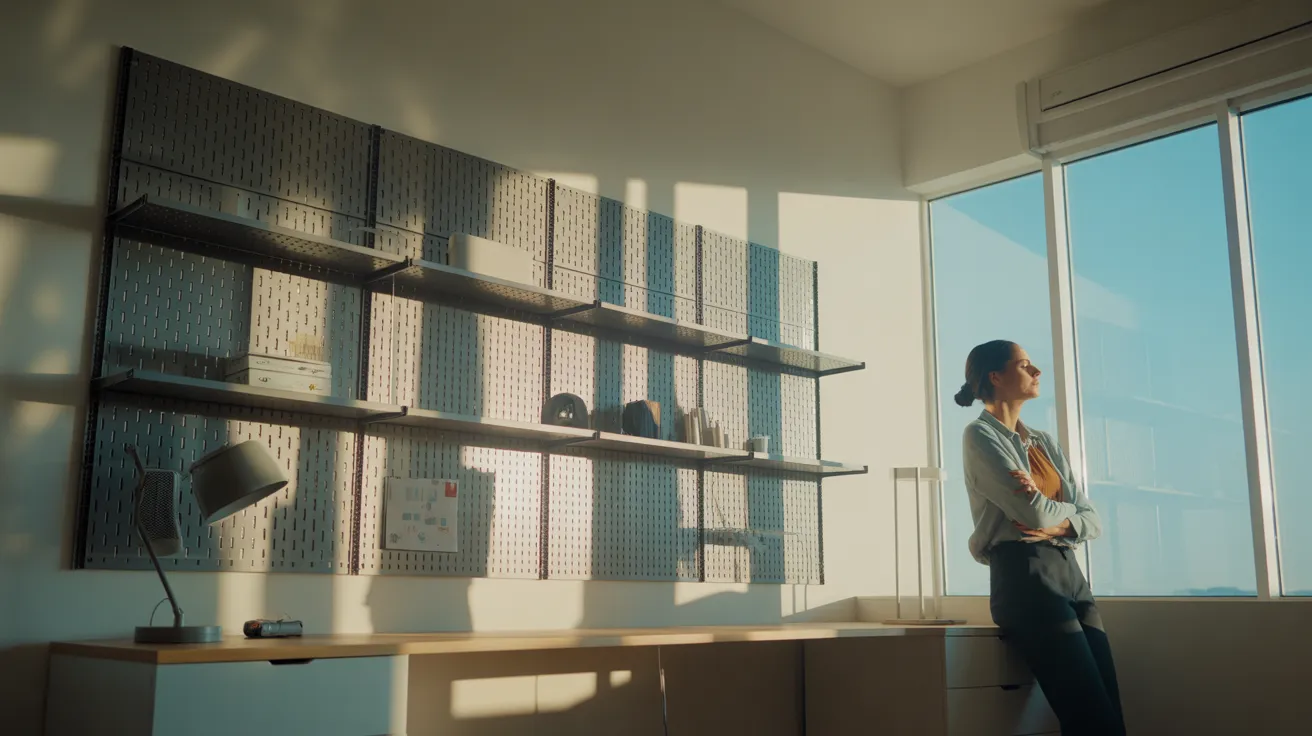
📚 Table of Contents
- The Core Idea: The Focus Block System
- Setting Up Your System for Success
- Execution: A Walk Through Your Day and Week
- Guardrails: Handling Interruptions and Overruns
- Optimization: The Weekly Review
- Real-World Scenarios: The System in Action
- Frequently Asked Questions (FAQ)
- What if my day is unpredictable or filled with meetings?
- How strict do I need to be with my time blocks?
- What’s the best tool for this? Digital or analog?
- I’ve tried time blocking before and it didn’t work. Why might that be?
- How is this different from just having a to-do list?
- Conclusion: Your First Steps to Fewer, Better Decisions
You’re standing in your kitchen, coffee brewing, the city outside buzzing to life. You open your laptop, and it hits you: a tidal wave of emails, a long list of tasks, and a calendar dotted with meetings. The first decision of the day is trying to decide what to do first. By 11 AM, you feel drained, and you haven’t even started your most important work. You’re not lazy or unmotivated. You’re experiencing decision fatigue.
Decision fatigue is the quiet exhaustion that settles in after you make too many choices, no matter how small. It degrades your ability to make good judgments, leading to procrastination, impulsivity, or simply choosing the easiest option instead of the best one. For busy professionals and students juggling countless responsibilities, this mental drain is a constant battle. The constant pressure of “what’s next?” chips away at your focus and energy.
Many time management systems promise a solution, but they often feel rigid, complex, and disconnected from the unpredictable nature of real life. They demand perfect execution, and one unexpected meeting can derail your entire day, leaving you feeling more defeated than before. But what if there was a different way? A way to build a structure that serves you, providing clarity without confining you. What if you could design your day to preserve your most valuable resource: your decision-making energy?
This article will guide you through a simple system designed to drastically reduce the number of decisions you make each day. It’s not about becoming a robot; it’s about becoming intentional. We will show you how to pre-make decisions about your time, freeing up your mind to do the deep, meaningful work that matters. This is your practical guide on how to make better decisions by making fewer of them.
The Core Idea: The Focus Block System
The solution to decision fatigue isn’t a new app or a complicated planner. It’s a fundamental shift in how you approach your day. Instead of reacting to a list of tasks, you proactively assign them a time and place. We call this the Focus Block System, and it combines two powerful, proven techniques: Time Blocking and Task Batching.
First, let’s define decision fatigue. The American Psychological Association, or APA, has published extensive research on willpower and self-control. Think of your decision-making ability like a muscle. Each time you use it—choosing an outfit, deciding which email to answer first, figuring out lunch—you tire it out. After a certain point, that muscle is exhausted, and its performance drops. This is why you might make a thoughtful business decision in the morning but order greasy takeout for dinner without a second thought.
The Focus Block System is one of the most effective decision fatigue solutions because it front-loads your choices. You make the big decisions once, at the beginning of the day or week, and then you simply execute the plan.
1. Time Blocking: Giving Every Minute a Job
Time blocking is the practice of scheduling your day into specific blocks of time dedicated to a particular task or group of tasks. Instead of a to-do list that you pull from, your calendar becomes your plan of action. A task isn’t just “write report”; it’s “9:00 AM – 11:00 AM: Write first draft of Q3 report.” This simple act eliminates the constant, low-grade stress of figuring out what to work on next.
2. Task Batching: Grouping Like with Like
Our brains are not designed for rapid multitasking. Every time you switch from one type of task to another—like jumping from writing a proposal to answering Slack messages to checking email—you incur a cost. This is called context switching. It takes time and mental energy for your brain to unload the context of the old task and load the context of the new one. Task batching is the antidote. It involves grouping similar, small tasks together into a single, dedicated time block. For example, instead of answering emails as they arrive, you create an “Email & Comms” block from 4:00 PM to 4:30 PM and handle them all at once.
By combining these two methods, the Focus Block System creates a clear, intentional roadmap for your day. You are no longer a victim of incoming requests. You are the architect of your own time and attention, preserving your best energy for your most important work.

Setting Up Your System for Success
The beauty of this simple system lies in its simplicity. You don’t need fancy software. A basic digital calendar like Google Calendar, Apple Calendar, or Outlook is perfect because of its flexibility. An analog planner can also work, but digital is often easier for adjusting to life’s inevitable changes.
Here’s how to configure your calendar to fight decision fatigue before it even starts.
Step 1: Choose Your Colors Intentionally
Color-coding is a powerful visual shortcut that tells your brain what kind of work is coming up without having to read a single word. This reduces cognitive load. You can create your own system, but here is a pragmatic starting point:
Blue for Deep Work: This color is for your most important, high-concentration tasks. Think writing, coding, strategic planning, or studying for a final exam. These blocks should be sacred.
Green for Shallow Work: This is for the administrative and logistical tasks that keep life moving. This includes answering emails, filing expenses, booking appointments, or making quick calls. Task batching is perfect for green blocks.
Orange for Meetings & Communication: This color signifies any time you are interacting with others. It includes scheduled meetings, collaborative work sessions, and even planned phone calls with family.
Gray for Logistics & Personal Time: This is for the non-negotiable parts of your life. Block out your lunch, workouts, breaks, and commute. Treating your personal time with the same respect as a work meeting is critical for preventing burnout.
Step 2: Schedule Buffers and Transit
One of the biggest reasons people fail at time blocking is that they are too optimistic. They schedule back-to-back meetings and tasks with no transition time. This is a recipe for stress and constant lateness. Instead, build in buffers.
A buffer is a 15-30 minute block of unassigned time between two major blocks. This gives you time to grab water, stretch, review notes for your next meeting, or simply let your mind rest. If a task runs over, the buffer absorbs the extra time, keeping your entire day from collapsing.
If you live in an urban area or commute, always block out your travel time. A “Commute to Office” block isn’t just dead time; it’s a fixed part of your day. You can even be intentional with it, deciding ahead of time whether you’ll listen to a podcast, an audiobook, or just enjoy some quiet time.
Step 3: Create Recurring Blocks for Routines
What parts of your week are predictable? Do you always have a team meeting on Monday mornings? Do you need to submit a report every Friday? Put these on your calendar as recurring events. Then, add personal routines. Maybe you want a recurring block every weekday from 12:30 PM to 1:30 PM for “Lunch & Walk.” Automating the scheduling of these routines removes dozens of small decisions from your week.
Your calendar is now more than a record of appointments. It is a visual representation of your priorities and a concrete plan for how you will invest your time and energy. This setup is your first line of defense in the battle for better decision making.

Execution: A Walk Through Your Day and Week
With your system set up, let’s see how it works in practice. The goal isn’t perfect adherence but intentional action. This is about guiding your focus, not locking you in a cage.
A Day in the Life with the Focus Block System
Imagine it’s Tuesday. Instead of waking up to the anxiety of an overwhelming to-do list, you glance at your calendar. The decisions have already been made.
7:30 AM – 8:30 AM (Gray Block): Morning Routine. This block protects your personal startup sequence. It could include exercise, meditation, breakfast with your family, or reading. You don’t have to decide what to do; you just follow the plan.
8:30 AM – 9:00 AM (Gray Block): Commute. You head to the office or your co-working space.
9:00 AM – 9:30 AM (Green Block): Daily Plan & Triage. You don’t dive into emails. You take 30 minutes to review your plan for the day, check for any urgent messages that might require a schedule change, and get your priorities straight. This is a proactive start, not a reactive one.
9:30 AM – 11:30 AM (Blue Block): Deep Work – Project Alpha Draft. This is your most important task of the day. You put your phone on silent, close unnecessary tabs, and dedicate two hours of pure focus to it. Because you pre-decided this, there’s no procrastination or negotiation with yourself.
11:30 AM – 12:00 PM (Gray Block): Buffer & Break. You get up, stretch, refill your water, and let your brain reset. You don’t check email. This break is crucial for maintaining energy.
12:00 PM – 1:00 PM (Orange Block): Team Sync Meeting. You arrive at the meeting prepared and on time because it was clearly marked on your schedule.
1:00 PM – 2:00 PM (Gray Block): Lunch. You take a full hour for lunch, away from your desk. This is a non-negotiable recharge period.
2:00 PM – 3:30 PM (Blue Block): Deep Work – Financial Model Analysis. Another high-concentration task, placed strategically after your lunch recharge.
3:30 PM – 4:00 PM (Green Block): Admin Batch. You process your email inbox, respond to Slack messages, and make a quick phone call. You do it all at once, efficiently, because you’re in the right mindset for rapid, shallow tasks.
4:00 PM – 5:00 PM (Orange Block): Client Call.
5:00 PM – 5:15 PM (Green Block): Daily Shutdown. You review what you accomplished, migrate any unfinished tasks, and plan your top priority for tomorrow. This creates closure and makes the next morning easier.
A Bird’s-Eye View of the Week
Zooming out, you can apply this logic to your entire week by theming your days. This further reduces decision fatigue. For example:
Mondays: Could be your “Planning & Meetings” day. You schedule most of your internal syncs and weekly planning sessions, getting the collaborative work done early.
Tuesdays & Thursdays: Could be your “Deep Work” days. You protect large, 4-hour blocks in the morning for your most critical projects, declining any meeting requests that conflict with them.
Wednesdays: Could be your “Client & External” day, dedicated to client calls, external meetings, and networking.
Fridays: Could be your “Wrap-up & Learning” day. You can finish smaller tasks, perform your weekly review, and dedicate time to professional development.
This weekly rhythm creates a predictable structure that helps you and your team know when you’re available and when you’re in focus mode. It’s a powerful tool for how to make better decisions about your time at a macro level.

Guardrails: Handling Interruptions and Overruns
A plan is just a guess. The real world is messy, and a truly pragmatic system must be flexible enough to handle it. Your calendar is a map, not a cage. Here’s how to manage the inevitable disruptions without abandoning your system.
When a Meeting Pops Up
Your boss requests an “urgent” 30-minute meeting right in the middle of your scheduled deep work block. The old you would have accepted immediately, derailing your focus. The new you sees this as a negotiation.
First, assess its true urgency. Can it be an email? Can it wait until your afternoon open slot? It’s okay to respond with, “Happy to connect. I’m in a deep work session on Project Alpha until 11:30. Would 2:00 PM work for you, or is it more urgent than the Alpha deadline?” This communicates your priorities and offers an alternative, reclaiming control over your schedule.
If the meeting is truly unavoidable, don’t just delete your deep work block. Shrink it or move it. Perhaps you can do 60 minutes of deep work before the meeting and schedule another 60-minute block later. The goal is to consciously re-allocate your time, not let it vanish.
When a Task Takes Longer Than Expected
You scheduled two hours to write a report, but you’re only halfway through when the block ends. This is a common issue, often related to Parkinson’s Law, the adage that work expands to fill the time allotted for its completion. While time blocking helps counter this by creating a container, estimates can still be wrong.
Don’t panic. You have a few options. First, use your built-in buffer time. That’s what it’s for. Second, at the end of the block, take five minutes to assess. Can you finish this with another 30 minutes of focus? If so, look at your schedule. Can you borrow time from a “shallow work” block? It’s better to trade low-value time for high-value time. Third, if it needs much more time, schedule a new deep work block for it later in the week and move on to your next scheduled task. This prevents one overrun from causing a domino effect of failure across your entire day.
The practice of setting a time limit for a task is also known as timeboxing. It’s a powerful cousin to time blocking that forces you to focus on getting the most important part of the task done within the allotted time, rather than striving for perfection.
Renegotiating Your Commitments
The core principle here is to be the master of your calendar, not its servant. When disruptions happen, you are not failing. You are simply gathering new information. The key is to make a conscious choice. Look at your schedule, understand the trade-offs, and renegotiate the plan for the rest of your day. This act of intentional re-planning is itself a powerful antidote to the feeling of chaos and a key skill for better decision making under pressure.

Optimization: The Weekly Review
A static system quickly becomes obsolete. To keep your Focus Block System effective and aligned with your goals, you need a simple feedback loop. This is the weekly review, a 30-60 minute block you should schedule for every Friday afternoon.
The purpose of the weekly review is not to judge your performance but to learn from it. It’s a moment of objective reflection that helps you make better decisions for the week ahead. During this session, you look back at your calendar from the past week and look forward to the commitments of the next.
Here are a few key metrics and questions to guide your review:
1. Energy Levels: Where Did You Thrive?
Scroll through your past week’s calendar. Don’t just look at what you did; try to remember how you felt. When did you feel most energized and focused? Was it during your Tuesday morning deep work block? When did you feel most drained? Was it after three back-to-back meetings on Wednesday? Energy is a critical metric for productivity. Poor sleep, for instance, has a well-documented negative impact on cognitive performance, as noted by organizations like the Sleep Foundation and research supported by the NIH. If you notice you’re consistently tired by 3 PM, maybe you need a longer lunch break or a short walk scheduled in the early afternoon.
2. Deep Work Count: Did You Protect Your Priorities?
Count the number of “Blue” (Deep Work) blocks you scheduled versus how many you actually completed without major interruption. This is a direct measure of how well you protected your focus time. If you scheduled ten but only managed four, why? Were meetings the primary culprit? Were you overly optimistic? This data helps you adjust your strategy for the next week, perhaps by blocking your focus time more assertively or communicating your schedule to your team.
3. Rollover Rate: What Didn’t Get Done?
How many tasks did you have to move from one day to the next? A high rollover rate can indicate a few things: you’re overestimating what you can do in a day, you’re not building in enough buffer time, or you’re allowing low-priority tasks to crowd out important ones. This is where the 80/20 Principle (also known as the Pareto Principle) comes in handy. This principle suggests that, for many events, roughly 80% of the effects come from 20% of the causes. Applied to your work, it means a small number of your tasks will generate the majority of your results. During your weekly review, identify that critical 20% and ensure they get a non-negotiable “Blue” block next week.
4. Planning for the Week Ahead
After looking back, look forward. Review your calendar for the upcoming week. Are there any major deadlines? Big meetings? Personal appointments? Start creating a tentative structure. Drag your key tasks from your to-do list onto your calendar, creating deep work blocks for them. Schedule your recurring routines. This simple act of pre-planning is one of the most powerful decision fatigue solutions, ensuring you start Monday morning with clarity and purpose, not confusion.

Real-World Scenarios: The System in Action
Theory is one thing, but practice is another. Let’s see how two different people, with very different lives, might apply the Focus Block System.
Scenario 1: Sarah, the Hybrid Tech Worker
Sarah works for a tech company, spending three days in the office and two days working from home. Her biggest challenge is managing context switching between collaborative in-office days and focused remote days.
Her In-Office Day (e.g., Tuesday): Sarah’s calendar is heavy on Orange (Meetings) blocks. She knows these days are for collaboration. She schedules a 9:00-10:00 AM block for a team stand-up and a 2:00-4:00 PM block for a project workshop. Her key strategy is to protect small pockets of focus. She blocks off 11:00 AM – 12:00 PM as a “Prep & Focus Sprint” (Blue Block) to prepare for the afternoon workshop. She also schedules a “Commute & Decompress” (Gray Block) from 5:30 PM – 6:30 PM to create a clear boundary between work and home life.
Her Work-From-Home Day (e.g., Thursday): This day is designed for deep work. Sarah blocks a large, three-hour “Deep Work: Code New Feature” (Blue Block) from 9:00 AM to 12:00 PM. She communicates her status on Slack as “Focus Mode” and turns off notifications. Her afternoon contains a batch-processed “Admin & Email” block (Green) and a few smaller tasks. By theming her days, she aligns her work environment with her tasks, dramatically improving her effectiveness and reducing the mental friction of trying to do deep work in a noisy office.
Scenario 2: Leo, the University Student
Leo is a second-year engineering student. He juggles classes, labs, a part-time job at the library, and a demanding study schedule. His challenge is a lack of unstructured time and feeling constantly behind.
Leo’s System Setup: First, Leo puts all his fixed commitments into his calendar as recurring Gray Blocks: “CHEM 202 Lecture,” “PHYSICS Lab,” “Library Shift.” This shows him his available “free” time. He realizes it’s not much, so he needs to be highly intentional.
How Leo Blocks His Week: He creates specific, task-oriented study blocks. Instead of a vague “Study” block, he schedules “CHEM 202 Problem Set” for two hours on Tuesday afternoon and “Write History Essay Outline” for 90 minutes on Wednesday morning. These are his Blue Blocks. He batches his errands into a single “Life Admin” block (Green) on Friday afternoon: groceries, laundry, and a trip to the post office. Critically, he also schedules “Downtime” and “Gym” blocks (Gray). This prevents burnout and ensures he protects his well-being, which is essential for learning. By externalizing his entire schedule, Leo stops carrying a massive mental to-do list, which frees up cognitive resources for his actual studies—a perfect example of a simple system providing clarity amidst chaos.

Frequently Asked Questions (FAQ)
What if my day is unpredictable or filled with meetings?
This is a common reality, especially for managers or those in client-facing roles. The goal in this scenario is to control what you can. First, block out your non-negotiables: lunch, a 15-minute planning session in the morning, and a 15-minute shutdown at the end of the day. Second, look for the small pockets of time between meetings. Instead of letting them evaporate, block them out as 20-minute “Focus Sprints” to handle one specific, small task. Even in a day of chaos, creating small islands of intention can be a powerful way to make progress and reduce the feeling of being purely reactive.
How strict do I need to be with my time blocks?
Think of your calendar as a guide, not a rigid set of rules. The purpose of the system is to serve you, not the other way around. If you finish a task early, you don’t have to sit there staring at the clock. You can either take a longer break or pull a small task forward from a later block. If a creative flow state strikes during a deep work block, and you have flexibility in your next block, consider extending it. The primary goal is intention. At the start of a block, you should know exactly what you’re supposed to be working on. That’s the core of how you avoid decision fatigue.
What’s the best tool for this? Digital or analog?
Both have their merits. Digital calendars (Google Calendar, Outlook) are excellent because they are flexible. You can easily drag and drop blocks, set up recurring events, and color-code. They are also accessible from any device. Analog planners (a paper notebook or dedicated planner) can be powerful for people who benefit from the physical act of writing. It can feel more permanent and mindful. The best tool is the one you will actually use consistently. We recommend starting with a digital calendar due to its ease of adjustment.
I’ve tried time blocking before and it didn’t work. Why might that be?
There are a few common pitfalls. The most frequent is not including buffer time. Scheduling tasks back-to-back creates a fragile system that breaks the moment one thing runs late. The second is being too optimistic about how long tasks will take. When you first start, try adding 25% to your initial time estimates. The third reason is failing to do a weekly review. Without this feedback loop, you can’t learn from your experiences and adjust your system. You just repeat the same mistakes. Start small, be realistic, and focus on gradual improvement.
How is this different from just having a to-do list?
A to-do list tells you what you need to do. A time-blocked calendar tells you what you need to do and when you are going to do it. This is a critical distinction. A long to-do list can be a source of anxiety and decision fatigue in itself. By assigning each task a home on your calendar, you are making a commitment and creating a realistic plan based on the 24 hours you actually have. It transforms your tasks from a vague list of obligations into a concrete, actionable plan.

Conclusion: Your First Steps to Fewer, Better Decisions
Decision fatigue is a silent drain on your productivity, creativity, and well-being. By constantly asking “what should I do next?”, we deplete the very mental energy needed to do our best work. The Focus Block System offers a pragmatic escape from this cycle. It is a simple system designed not for perfect, robotic execution, but for human-centered intentionality. By pre-deciding how you’ll spend your time, you liberate your mind to focus on the task at hand.
You don’t need to overhaul your entire life overnight. The path to better decision making starts with small, deliberate steps. You can reclaim control of your time and attention, one block at a time.
Here are three simple actions you can take this week to get started:
1. Choose Your Tool and Colors. Open your preferred calendar (like Google Calendar) right now. Create four or five color-coded event categories: Deep Work, Shallow Work, Meetings, and Personal Time. This takes less than five minutes but sets the entire foundation.
2. Block Your Top 3 for Tomorrow. Don’t try to schedule your entire day yet. Just look at your to-do list for tomorrow and identify your top one to three priorities. Create realistic time blocks for them on your calendar. Make sure to give them a “Deep Work” color.
3. Schedule One Buffer. Look at your schedule for tomorrow and find two back-to-back events. Intentionally schedule a 15-minute “Buffer” block between them. Experience the freedom of having built-in transition time, even if it’s just once.
By taking these small steps, you are beginning the process of transforming your calendar from a passive record of events into your most powerful tool for focused, intentional living.
Disclaimer: This article is for informational purposes only and does not constitute medical, legal, or financial advice. Please consult a qualified professional for advice tailored to your specific situation.






